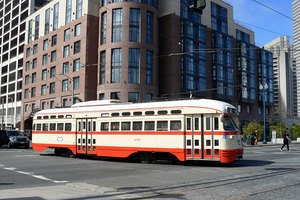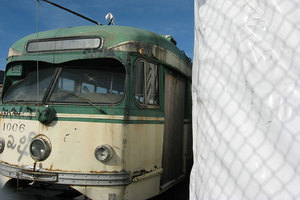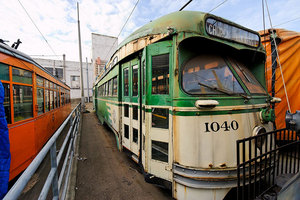Muni’s governing body, the San Francisco Municipal Transportation Agency (SFMTA), has issued requests for proposals from outside contractors on a crucial project for historic transit in the city. The SFTMA is seeking proposals from outside vendors to double the current number of operational PCC streetcars, the mainstay of F-line (and future E-line) service. Sixteen rebuilt or renovated PCCs would reach the streets under this plan, matching the sixteen currently operating.

Frank Zepeda photo.
The biggest single operational benefit will come from making the eleven ex-Newark PCC cars (Nos. 1070-1080) completely reliable. These cars had already received interior and exterior renovation and were being placed into service in April 2007 when wiring problems were discovered (despite having had a sample Newark car, now No. 1070, in San Francisco for an extended test period before purchasing the group). As a result, only four of these cars have actually carried paying passengers (Nos. 1075, 1077, 1078, and 1079) and at press time, only No. 1079 is currently in service. Muni maintenance staff has tried a variety of fixes for the wiring problems, with little lasting success. Both Muni leadership and Market Street Railway agree that complete replacement of the original 1946-48 wiring is needed to create reliably operating cars. That rewiring is part of the scope of this new contract, which calls for delivering the rewired cars to Muni by March 2010.

Whole Wheat Toast photo.
The same contract includes the complete rebuilding of the four remaining double-end PCCs on Muni property (Nos. 1006, 1008, 1009, and 1011). These cars, purchased new by Muni in 1948, are today non-operational and in various stages of decrepitude. They would receive essentially the same renovation given to their twins, Nos. 1007, 1010 & 1015, in the original F-line car renovation program, carried out in the early 1990s. As our regular Inside Track readers know, the renovation of the four additional double-enders has been delayed several times for one reason or another, spanning more than a decade now. If all goes as planned with this contract, though, they will be delivered to Muni, rebuilt like new, by the end of February, 2011.

Jim Maurer photo.
As a bonus, this contract also includes the complete renovation of PCC No. 1040, the last of 10,000 cars of this type built in North America, delivered new to Muni in 1952, and now scheduled to be returned like new in August, 2010.
Proposals for this job are due from contractors on September 18. Muni bundled the various PCC rehabilitation jobs together to create a large package, with the hope of attracting multiple bidders, including major multi-national transit firms. A Muni team will review the offered proposals, conduct oral interviews with the proposers, and accept proposals on price, after which the successful contractors will be selected. If there are no protests from unsuccessful proposers, and provided the Board of Supervisors approves the contract, work could begin early in 2009.
We’ll keep you updated here at the Market Street Railway Blog on the progess of this important contract.
would like to become a member and receive news letters and even help work but I live back in Iowa would there be some place to stay for a couple of weeks I would be able to make a sizeable donation please advise
Gerald, please send me your email contact or phone and I will get in touch with you. Send it to me directly at rlaubscher@streetcar.org
Hi there,Rick,tell me what is the issue of the PCC double end 1014,do they want money or they refuse to give it up,
thanks.
That car was placed on “permanent loan” by the City of San Francisco to a railway museum in Sydney, Australia quite a few years ago. The museum has invested a significant amount of effort into restoring the car and wishes to keep it. Any change in its status is something that would have to be decided between Muni and the museum.
Hi there, Rick,why Muni purchase the 2 PCC cars 4008 and 4009 now saying it needs regauging and ada,is this expensive and difficult??thanks..
Muni procured the cars for around $5000 each, so their investment in them is minimal. At the time, it was thought prudent to get as many PCCs as could be cheaply acquired, to provide options for future restoration. Since those cars were acquired, Muni has set a priority of trying to standardize around as few PCC types as possible, for training, operation, and maintenance simplification. Even if ADA and regauging were accomplished, these cars would be “oddballs” as different from the other cars in so many ways. So they are not a current priority for Muni.
Hi Rick,well,MUNI has 4 or 3 different PCC cars,you mean
the 4008 and the 4009 have the pedals in different position and this would confuse the drivers?,I thought this two ware like the 1000s or the 1100s,thanks.
The pedals are the same I believe but there are other significant differences in the dashboard, control system, etc., which may well require separate training for all operators on these cars if they’re part of the operating fleet.
Rick I do agree that they are different,, but many many members believe that at least one should be converted and used. The fact that they are different and need training of operators is not a reason to permanently sideline these two PCCs. We should certainly try to do at least one at minimal cost and see where we are then. I am certain that Muni operators could certainly learn to operate them
Why bother with two oddballs if Muni is already working on these 16? It’s doubtful most F-line riders notice anything beyond the paint job, so they don’t add value for anyone besides the railfans. The added cost of training, maintenance and whatnot would actually take away from Muni being able to do other, more interesting things.
If Muni is going to work on any oddball cars, I’d much rather see something besides PCCs. With the PCCs that have been added in the last few years and the orange Italian cars being repainted for other time periods, the F-line is looking more and more like it’s just the same cars with different paint jobs.
The only really interesting car that ever comes up to Castro is Zurich and I’d like to know if it’s possible for Muni to get a batch of those so they wouldn’t just be one off “oddballs”? How many do they need to bring the maintenance and training costs down? Would it be possible to get more of the cars from Australia or New Orleans, I know you already have a couple of those, to bring the costs down to the point they could run them on the entire F-line so it’s not just the tourists who get to enjoy them along the piers?
@ Cary Brotman – If only there were such a thing as “doing one at minimal cost.” Regauging trucks, installing VETAG switching, front trolley poles, etc. to meet Muni requirements is always expensive, so it’s important that before an investment is made in a car, it will actually be used. The fact is that besides the extra training involved, history shows that “oddball” vehicles — ones with significantly different operating characteristics from the norm — do not get used much in transit systems. If a “normal” car is available, most operators will reject the oddball. So it makes sense to avoid introducing additional equipment types.
The “Zurich” car actually ran in Brussels, and was acquired by Muni a few years ago when a batch of them was retired. At the time, the thinking was that because the car is actually a PCC (despite the Euro body), it could be maintained and operated in pretty much the same way as the other PCCs. Upon arrival, though, Muni found that the car had been modified numerous times with different generations of electronics, which were not standard at all, and that took a lot of learning to get on top of. Perhaps more importantly, the car is so skinny (for those narrow Belgian streets) that it doesn’t have all that much capacity. In fact, if Mayor Newsom hadn’t made it into a “Zurich” car to honor one of our sister cities (the body is pretty similar, anyway), it probably would be on the street less than it actually is.
The question about more variety on the F-line is an excellent one. We’ll explore it in a future posting.